Feldspar
- This article is about a mineral. For the Malcolm in the Middle character see list of characters.
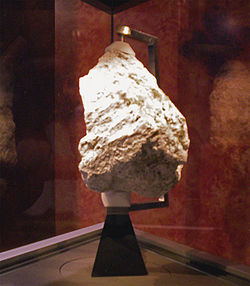
Lunar Ferroan Anorthosite #60025 (Plagioclase Feldspar). Collected by Apollo 16 from the Lunar Highlands near Descartes Crater. This sample is currently on display at the National Museum of Natural History in Washington, D.C., USA. (Unknown scale.)
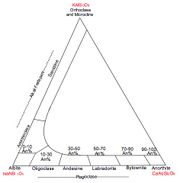
Compositional phase diagram of the different minerals that constitute the feldspar solid solution.
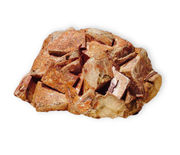
Feldspar.
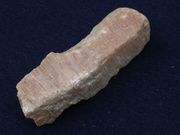
Alkali feldspar perthite (7cm long X 3cm width).
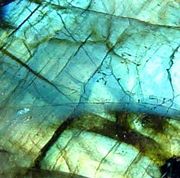
Labradorite.
Feldspar output in 2005. Click the image for the details.
|
||||||||||||||||||||||||||||||||||
Feldspars (KAlSi3O8 - NaAlSi3O8 - CaAl2Si2O8) are a group of rock-forming tectosilicate minerals which make up as much as 60% of the Earth's crust.[1]
Feldspars crystallize from magma in both intrusive and extrusive igneous rocks, as veins, and are also present in many types of metamorphic rock.[2] Rock formed almost entirely of calcic plagioclase feldspar (see below) is known as anorthosite.[3] Feldspars are also found in many types of sedimentary rock.[4]
Contents |
Etymology
Feldspar is derived from the German Feld, "field", and Spath, "a rock that does not contain ore". "Feldspathic" refers to materials that contain feldspar. The alternative spelling, felspar, has now largely fallen out of use.[5]
Compositions
This group of minerals consists of framework or tectosilicates. Compositions of major elements in common feldspars can be expressed in terms of three endmembers:
Potassium-Feldspar (K-spar) endmember KAlSi3O8[1]
Anorthite endmember CaAl2Si2O8[1]
Solid solutions between K-feldspar and albite are called alkali feldspar.[1] Solid solutions between albite and anorthite are called plagioclase,[1] or more properly plagioclase feldspar. Only limited solid solution occurs between K-feldspar and anorthite, and in the two other solid solutions, immiscibility occurs at temperatures common in the crust of the earth. Albite is considered both a plagioclase and alkali feldspar. In addition to albite, barium feldspars are also considered both alkali and plagioclase feldspars. Barium feldspars form as the result of the replacement of potassium feldspar.
Alkali feldspars
The alkali feldspars are as follows:
- orthoclase (monoclinic),[6] — KAlSi3O8
- sanidine (monoclinic)[7] —(K,Na)AlSi3O8
- microcline (triclinic)[8] — KAlSi3O8
- anorthoclase (triclinic) — (Na,K)AlSi3O8
Sanidine is stable at the highest temperatures, and microcline at the lowest.[6][7] Perthite is a typical texture in alkali feldspar, due to exsolution of contrasting alkali feldspar compositions during cooling of an intermediate composition. The perthitic textures in the alkali feldspars of many granites can be seen with the naked eye.[9] Microperthitic textures in crystals are visible using a light microscope, whereas cryptoperthitic textures can be seen only with an electron microscope.
Plagioclase feldspars
The plagioclase feldspars are triclinic. The plagioclase series follows (with percent anorthite in parentheses):
- albite (0 to 10) — NaAlSi3O8
- oligoclase (10 to 30) — (Na,Ca)(Al,Si)AlSi2O8
- andesine (30 to 50) — NaAlSi3O8 — CaAl2Si2O8
- labradorite (50 to 70) — (Ca,Na)Al(Al,Si)Si2O8
- bytownite (70 to 90) — (NaSi,CaAl)AlSi2O8
- anorthite (90 to 100) — CaAl2Si2O8
Intermediate compositions of plagioclase feldspar also may exsolve to two feldspars of contrasting composition during cooling, but diffusion is much slower than in alkali feldspar, and the resulting two-feldspar intergrowths typically are too fine-grained to be visible with optical microscopes. The immiscibility gaps in the plagioclase solid solution are complex compared to the gap in the alkali feldspars. The play of colours visible in some feldspar of labradorite composition is due to very fine-grained exsolution lamellae.
Barium feldspars
The barium feldspars are monoclinic and comprise the following:
- celsian — BaAl2Si2O8
- hyalophane — (K,Na,Ba)(Al,Si)4O8
Feldspars can form clay minerals through chemical weathering.[10]
Uses
- Feldspar is a common raw material in the production of ceramics and geopolymers.
- Feldspars are used for thermoluminescence dating and optical dating in earth sciences and archaeology
- Feldspar is one of several abrasive ingredients in Bon Ami, a brand of household cleaner in the USA.
In 2005, Italy was the top producer of feldspar with almost one fifth of world share, followed by Turkey, China and Thailand—reports the International Monetary Fund.
See also
- List of minerals
References
- ↑ 1.0 1.1 1.2 1.3 1.4 1.5 Feldspar. What is Feldspar? Industrial Minerals Association. Retrieved on July 18, 2007.
- ↑ "Metamorphic Rocks." Metamorphic Rocks Information. Retrieved on July 18, 2007
- ↑ Blatt, Harvey and Robert J. Tracy, Petrology, Freeman, 2nd ed., 1996, pp. 206-210 ISBN 0-7167-2438-3
- ↑ "Weathering and Sedimentary Rocks." Geology. Retrieved on July 18, 2007.
- ↑ Harper, Douglas. "feldspar". Online Etymology Dictionary. http://www.etymonline.com/index.php?term=feldspar. Retrieved 2008-02-08.
- ↑ 6.0 6.1 "The Mineral Orthoclase." Feldspar Amethyst Galleries, Inc. Retrieved on February 8, 2008.
- ↑ 7.0 7.1 "Sanidine Feldspar." Feldspar Amethyst Galleries, Inc. Retrieved on February 8, 2008.
- ↑ "Microcline Feldspar." Feldspar Amethyst Galleries, Inc. Retrieved on February 8, 2008.
- ↑ Ralph, Jolyon & Ida. "Perthite." Perthite Profile on mindat.org Retrieved on February 8, 2008.
- ↑ Nelson, Stephen A. (Fall 2008). "Weathering & Clay Minerals". Professor's lecture notes (EENS 211, Mineralogy). Tulane University. http://www.tulane.edu/~sanelson/eens211/weathering&clayminerals.htm. Retrieved 2008-11-13.
- Bonewitz, Ronald Louis. (2005). Rock and Gem, New York: DK Publishing. ISBN 978-0-7566-3342-4